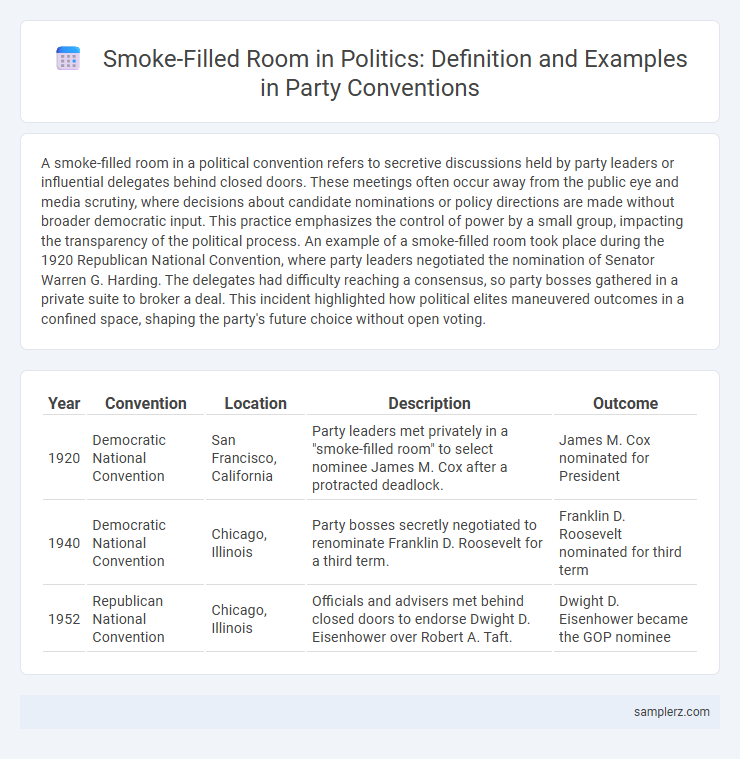A smoke-filled room in a political convention refers to secretive discussions held by party leaders or influential delegates behind closed doors. These meetings often occur away from the public eye and media scrutiny, where decisions about candidate nominations or policy directions are made without broader democratic input. This practice emphasizes the control of power by a small group, impacting the transparency of the political process. An example of a smoke-filled room took place during the 1920 Republican National Convention, where party leaders negotiated the nomination of Senator Warren G. Harding. The delegates had difficulty reaching a consensus, so party bosses gathered in a private suite to broker a deal. This incident highlighted how political elites maneuvered outcomes in a confined space, shaping the party's future choice without open voting.
Table of Comparison
| Year | Convention | Location | Description | Outcome |
|---|---|---|---|---|
| 1920 | Democratic National Convention | San Francisco, California | Party leaders met privately in a "smoke-filled room" to select nominee James M. Cox after a protracted deadlock. | James M. Cox nominated for President |
| 1940 | Democratic National Convention | Chicago, Illinois | Party bosses secretly negotiated to renominate Franklin D. Roosevelt for a third term. | Franklin D. Roosevelt nominated for third term |
| 1952 | Republican National Convention | Chicago, Illinois | Officials and advisers met behind closed doors to endorse Dwight D. Eisenhower over Robert A. Taft. | Dwight D. Eisenhower became the GOP nominee |
Historic Origins of the “Smoke-Filled Room” in Political Conventions
The term "smoke-filled room" originated during the 1920 Republican National Convention, where party leaders retreated to a small, smoke-filled hotel suite in Chicago to negotiate the presidential nominee away from public scrutiny. This clandestine setting exemplified the era's behind-the-scenes political maneuvering, where power brokers wielded significant influence over the outcome, often sidelining grassroots voices. The practice highlighted the lack of transparency in early 20th-century conventions, shaping modern reforms aimed at increasing openness in the nominating process.
The 1920 Republican National Convention: A Classic Example
The 1920 Republican National Convention exemplified a smoke-filled room where party leaders secretly negotiated to nominate Warren G. Harding as the presidential candidate. Behind closed doors, influential delegates and political bosses bypassed broader party input, shaping the election outcome through discreet deal-making. This convention remains a defining historical instance of undemocratic decision-making processes within American political conventions.
Behind Closed Doors: Decision-Making Away from the Public Eye
During the 1920 Republican National Convention, party leaders gathered in a smoke-filled room to select Warren G. Harding as their presidential candidate, exemplifying decision-making away from the public eye. This secretive process bypassed the broader delegate input, highlighting how power brokers influence outcomes behind closed doors. Such conventions reveal the tension between democratic transparency and concentrated political influence.
Influential Power Brokers and Their Hidden Agendas
Influential power brokers in smoke-filled rooms at political conventions maneuver behind closed doors to shape candidate selections and policy decisions, often prioritizing hidden agendas over transparent democratic processes. These insiders leverage their control over delegate commitments, media narratives, and party resources to consolidate power and influence outcomes to align with their strategic interests. The lack of public scrutiny in such environments enables covert negotiations that significantly impact party platforms and election results.
Impact of Backroom Deals on Delegate Decisions
Backroom deals in smoke-filled rooms during political conventions significantly influence delegate decisions by prioritizing strategic alliances over transparent voting. These secret negotiations often lead to the selection of candidates who may not reflect the broader delegate preferences but rather the interests of powerful party insiders. Consequently, such practices can undermine democratic processes and alter the direction of party platforms.
How “Kingmakers” Shaped Presidential Nominations
In the 1968 Democratic National Convention, smoke-filled rooms symbolized the covert negotiations where party elites, or "kingmakers," wielded disproportionate influence over presidential nominations. These senior officials and influential delegates brokered deals behind closed doors, sidestepping the broader electorate to select candidates aligned with party interests. This practice underscored power dynamics within political conventions, highlighting the tension between grassroots participation and elite control.
The Legacy of the 1920 Chicago Hotel Suite Negotiations
The 1920 Chicago convention's smoke-filled hotel suite negotiations symbolize the era's opaque political decision-making, where party leaders covertly selected Warren G. Harding as the Republican presidential nominee. This clandestine pact sidelined progressive candidates, underscoring the influence of backroom deals on national politics. The event's legacy highlights ongoing debates about transparency and democracy within party nomination processes.
Public Perception and the Democratic Deficit in Conventions
Smoke-filled rooms in political conventions epitomize backroom deals where party elites select candidates away from public scrutiny, fueling perceptions of undemocratic practices. This lack of transparency exacerbates concerns about the democratic deficit, undermining trust in the electoral process and alienating voters seeking genuine representation. Modern reforms strive to increase openness, yet remnants of opaque negotiations continue to challenge the legitimacy of convention outcomes.
Reforms Spurred by “Smoke-Filled Room” Practices
The 1920 Republican National Convention exemplified smoke-filled room dynamics, where party leaders secretly selected Warren G. Harding as the nominee, bypassing broader delegate input. This opaque dealmaking spurred calls for reforms aimed at increasing transparency and democratizing candidate selection processes within political parties. As a result, subsequent changes included stricter rules on delegate voting and the rise of primary elections to reduce elite control over nominations.
Modern Parallels: Are Smoke-Filled Rooms Gone for Good?
Modern parallels to the smoke-filled room phenomenon persist in the form of closed-door political strategy sessions and backroom negotiations within party conventions and legislative caucuses. Despite calls for transparency, influential deal-making often occurs out of public view, shaping candidate selections and policy agendas behind the scenes. This continuity of shadowy deliberations reveals that smoke-filled rooms have evolved rather than disappeared in contemporary political processes.

example of smoke-filled room in convention Infographic
 samplerz.com
samplerz.com